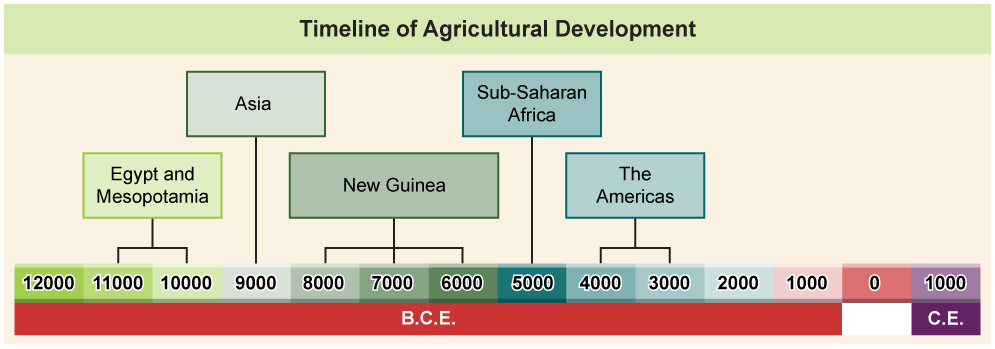| << Chapter < Page | Chapter >> Page > |

Agriculture began with the simplest of technologies—for example, a pointed stick to break up the soil—but really took off when people harnessed animals to pull an even more efficient tool for the same task: a plow. With this new technology, one family could grow enough crops not only to feed themselves but others as well. Knowing there would be abundant food each year as long as crops were tended led people to abandon the nomadic life of hunter-gatherers and settle down to farm.
The improved efficiency in food production meant that not everyone had to toil all day in the fields. As agriculture grew, new jobs emerged, along with new technologies. Excess crops needed to be stored, processed, protected, and transported. Farming equipment and irrigation systems needed to be built and maintained. Wild animals needed to be domesticated and herds shepherded. Economies begin to develop because people now had goods and services to trade.
As more people specialized in nonfarming jobs, villages grew into towns and then into cities. Urban areas created the need for administrators and public servants. Disputes over ownership, payments, debts, compensation for damages, and the like led to the need for laws and courts—and the judges, clerks, lawyers, and police who administered and enforced those laws.
At first, most goods and services were traded as gifts or through bartering between small social groups (Mauss 1922). Exchanging one form of goods or services for another was known as bartering . This system only works when one person happens to have something the other person needs at the same time. To solve this problem, people developed the idea of a means of exchange that could be used at any time: that is, money. Money refers to an object that a society agrees to assign a value to so it can be exchanged for payment. In early economies, money was often objects like cowry shells, rice, barley, or even rum. Precious metals quickly became the preferred means of exchange in many cultures because of their durability and portability. The first coins were minted in Lydia in what is now Turkey around 650–600 B.C.E. (Goldsborough 2010). Early legal codes established the value of money and the rates of exchange for various commodities. They also established the rules for inheritance, fines as penalties for crimes, and how property was to be divided and taxed (Horne 1915). A symbolic interactionist would note that bartering and money are systems of symbolic exchange. Monetary objects took on a symbolic meaning, one that carries into our modern-day use of checks and debit cards.
Imagine having no money. If you wanted some french fries, needed a new pair of shoes, or were due to get an oil change for your car, how would you get those goods and services?
This isn’t just a theoretical question. Think about it. What do those on the outskirts of society do in these situations? Think of someone escaping domestic abuse who gave up everything and has no resources. Or an immigrant who wants to build a new life but who had to leave another life behind to find that opportunity. Or a homeless person who simply wants a meal to eat.
This last example, homelessness, is what caused Heidemarie Schwermer to give up money. A divorced high school teacher in Germany, Schwermer’s life took a turn when she relocated her children to a rural town with a significant homeless population. She began to question what serves as currency in a society and decided to try something new.
Schwermer founded a business called Gib und Nimm —in English, “give and take.” It operated on a moneyless basis and strived to facilitate people swapping goods and services for other goods and services—no cash allowed (Schwermer 2007). What began as a short experiment has become a new way of life. Schwermer says the change has helped her focus on people’s inner value instead of their outward wealth. It has also led to two books telling her story (she’s donated all proceeds to charity) and, most importantly, a richness in her life she was unable to attain with money.
How might our three sociological perspectives view her actions? What would most interest them about her nonconventional ways? Would a functionalist consider her aberration of norms a social dysfunction that upsets the normal balance? How would a conflict theorist place her in the social hierarchy? What might a symbolic interactionist make of her choice not to use money—such an important symbol in the modern world?
What do you make of Gib und Nimm ?

Notification Switch
Would you like to follow the 'Introduction to sociology & Social change' conversation and receive update notifications?